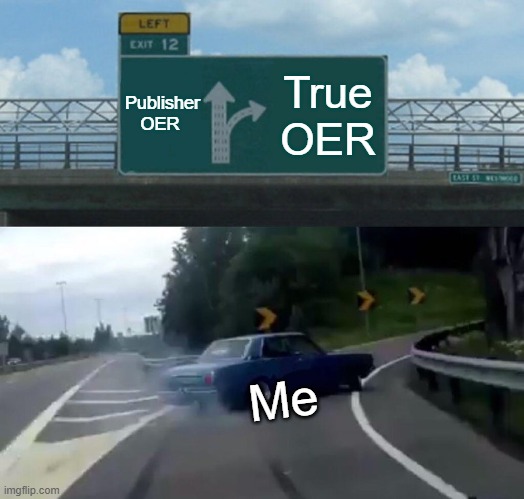It’s Not About The Money… except when it is
So much is going on, but rather than touch on a point that so many people are writing about for March 2020, I am going to go in a very different direction. I want to talk to you about Open Educational Resources and my experiences with OER and my campus. On February 28th and 29th, I attended the 2020 Arizona Regional OER Conference, lovingly referred to as OERizona20. I want to talk about that conference, but I also want to set a little context.
Now, this wasn’t my first experience with OER. I started out with the Maricopa Millions sponsored workshops with Matthew Bloom, working to complete an OER Passport. I joined the “OER Faculty Workshop” on canvas. The course is also available at https://www.canvas.net/ (the public Canvas MOOC site) by searching for “Making the Transition to Open.”
It got me excited. Then, I was offered the chance to do an OER pilot with a mentor using a publisher created OER course. So, I spent a semester using the materials and exploring my student’s reactions.
I planned out my following semester with the intent to use the publisher supported OER. I left for the winter break secure in the knowledge that I was ready to go and returned for the Spring semester to discover the publisher wasn’t prepared and wouldn’t be until several weeks after the start of the semester, and my course was already advertised as OER. So, I took a major turn.

I dove in face first and I did a backward-design driven OER adaptation. I had resources available to me and I took to it like a fish to water. I completed the semester with the feeling that it was the best semester I had ever had. The material was so much more personalized to my style of teaching and adaptable to many different learning approaches. I was able to try new things at every turn. The student feedback was resoundingly positive and I walked away on a high.
It was such a positive experience that I decided to give a “lightning talk” about my experiences at an OER conference: The 16th Annual Open Education Conference. It was at this particular conference that I learned that I was not alone. In fact, I felt particularly foolish as I discovered the breadth and depth of support available to me as faculty moving towards open educational resources: the librarians, the faculty developers, the instructional developers, and the OER committee. All of these resources were available to me on my own campus. I had all the support I could possibly have used. I had done it alone through ignorance. While it had gone fantastic, unbelievably, it could have been even better! Realizing I still had so much to learn, I got involved with the OER committee on the campus and began to research and read and really learn what I was missing.
That brings me to February and #OERizona20. I am going to share just a few of the sessions I attended, primarily those that had me walk away even more excited than before.
The first session I attended was presented by a few ASU faculty who talked about their “failed” attempt at getting a fully online program to adopt OER. They called their session “Failure to Launch”. But it wasn’t. Their session talked about needing faculty and program buy-in, field-specific standards, issues with current publications (a library issue), and not doing the “all or nothing” approach. It was a great session that really looked at the barriers to success.
This was followed by a session on the Z-degree program at Mesa Community College. A lot of that session talked about unnecessary barriers, cost reduction to students, appropriate tagging of courses, having a Quality Matters (QM) foundation, and the process of working with instructional designers.
One of the biggest takeaways that I had from this session was that instructional designers really do want to help you put everything in Canvas. In the session, the instructional designer said “Most teachers say they like creating in Canvas, but when they discover the joy of having an instructional designer help, it turns out they don’t really love creating in Canvas.” I’m going to have to test that theory because I really do love creating in Canvas.
The next session was on overcoming ImpostOER syndrome, do we have the right “Koalifications” she asked us in a meme. The answer was a resounding yes! I want to share all of the information I got from that session, as it was so supportive of the possibilities.
Step 1. Publishers don’t own most of the information.
Openly licensed images will go with most things.
Step 2. You are already curating the information.
You decide how to share the information
You are already creating materials
Just add the creative commons license and it can be used.
Step 3. Start small
- Novice Level
- Start with one resource
- Use existing resources where possible
- Stick with the most “Open” creative commons licenses
- Intermediate
- Adapt resources- copy and paste with multiple (open resources) edit, rewrite small sections
- Learn about licensing.
- Advanced
- Write your own textbook
Step 4: Don’t reinvent the wheel
- Ask colleagues
- Repositories
Step 5: Work Together
- Instructors
- Librarians
- CTLE
- Ed Technologists
- Instructional Designers
- OER Specialists
Step 6: Keep track of your sources
- Provide appropriate attribution. Open Washington attribution builder was a resource she used for the sources that she found. In Canvas it is built-in Open Attribution Builder in canvas for some campuses. Proper citation yeah!
Step 7: Use technology to your advantage and with which you are comfortable.
- Google Docs
- Press books
- Canvas
- OER wrap-around services (Like Lumen Learning)
- Pixabay OER Images
- Wikimedia
Step 8: Open up work to peer review
Step 9: Realize just how awesome you are!
$336,000 (personal savings she has done for students)
And that was all before lunch on the first day.
This was followed by the concept of Open Active Textbooks, a merging of active learning and OER. An open active textbook is graphics, text, references, activities, videos, tools, and active learning experiences. It is a reimagined learning resource in the same way a phone has been reimagined from the rotary to modern smartphones.
He ended with the quote “It is kind of fun to do the impossible” from Walt Disney
All in all, that first day was incredible and really helped me to grasp what I was missing, collaboration. My forays into Open had been independently driven and while it was great, my semester could have been so much more had I known the questions to ask and the people to reach out to.
My second day had two sessions that really stand out.
The first was about getting started with open assignments. This was a highly informative session that talked about using backward design and using the course competencies to build the text and the open assignments. A few takeaways:
Renewable assignments are:
- Are students asked to create new artifacts or revise/remix existing OER?
- Does the new artifact have value beyond supporting the learning of the author?
- Are students invited to publicly share their completed work?
- Are students invited to publicly license their completed work?
- Try making one of your current assignments more open
- Increase the audience to more than you just seeing it (Watch for legalities) – Share within a class
- Make an assignment open to the class, if you aren’t ready to be open to the public
- Use Google products for sharing
- Use features in Canvas
Things she tried
- Open Study Guides
- Student Written Quiz Questions
- Used Canvas Collaborations for group work
- Open assignments – using Google Docs
- Most-difficult-concept videos created by students for students
The second session was on OER and accessibility. The session had a lot of valuable information. While access is at the heart of Open Educational Resources, accessibility should be at the top. The session began with a serious talk about Universal Design for Learning with the course and assignment designs. Then, she went into the top tips.
Tip 1: Add Accessibility Statements to your syllabus and/or course home page.
Include
- Disability Accommodation Statement
- Links to vendor accessibility information for software of materials used in your course
Tip 2: Fix Semantic Structure (Style)
Headers, strong, emphasis, for screen readers
Tip 3: True Bulleted or Numbered Lists, True Columns, True Tables and don’t allow rows to break across pages
Tip: 4 Ensure Readability
Break large blocks of text into usable chunks and use a sans serif font like Verdana.
Tip 5: Text Equivalents: Always use alt text for images.
Tip 6: Avoid color coding alone as a means of conveying information
Use something other than color with meaning.
Tip 7:Readibility, a second look. Use an ability checker for color contrast issues. Make sure it is high contrast.
Tip 8: Descriptive Hyperlinks
Links should make sense out of context. Screen readers have a links-only mode. Write links so that out of context they will make sense.
Tip 9: Use Accessibility Checkers
HHS.Gov is quite intimidating but is comprehensive
Tip 10: Caption and use transcripts.
This was an important session for me for several reasons. First, accessibility is SOOOOO important and I want to make sure my materials are accessible to every student. As of the date, I am writing this in March 2020, accessibility is even more important to me than ever. Following many of these tips help everyone, not just those students who need it.
Second, I now knew an instructional developer who was at my own campus, who I had known for quite a while without realizing it, and who could and would be a resource for me as I move further into OER. No excuses, all of the resources are at my disposal.
Are you still with me?
Let me boil it down for you in a TLDR.
I started my adventures with OER ignorant. I didn’t know what I didn’t know. I didn’t know who I should be talking to. I didn’t know the questions to ask. It has been the complete experience of the past 2 years that have brought me to the point that I now know that I don’t have to go it alone. More importantly, working with the support that is available will make everything that much better, for me and for my students.
So, I would like to end with what my next step has been. After the OERizona20 conference, I reached out through the OER Committee on my campus to a librarian and gave my input on the creation of a libguide for faculty interested in getting started with OER. I did this for me and I did this for you. Because you might be like me and be daring and willing to jump into the deep-end to give it a try, but you shouldn’t have to.
We have the support and using that support can only make the good, better.
And, I have to add that attending the #OERizona20 conference resulted in some of the best conference swag, ever! Take a look at the rocking socks.
And yes, you will catch me sporting these babies.


